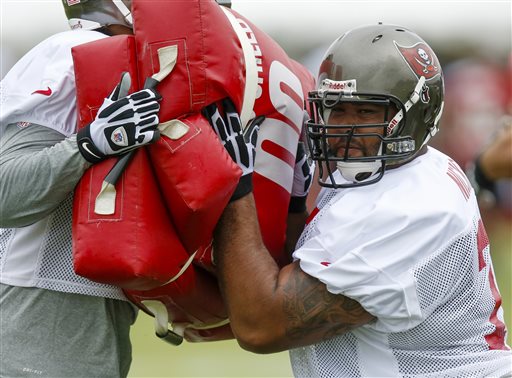(AP) MRSA: a silent danger lurking in NFL locker rooms
By EDDIE PELLS
AP National Writer
At the first sign a potentially deadly strain of staph infection was coursing through the Washington Redskins’ locker room, owner Daniel Snyder told his trainer to spare no expense.
So, Bubba Tyer embarked on a renovation that ran nearly $80,000.
“A major, major project,'” Tyer said, referring to the 2006 remodeling of the team’s headquarters. “But it was something that had to be done. `”
As the recent cases of Methicillin-resistant Staphylococcus aureus (MRSA) infection in Tampa Bay have reminded players, owners and trainers across the league, the NFL has safety issues not only on the playing fields, but lurking in the corner of its locker rooms as well. Scrapes and cuts can be every bit as dangerous as the hard hits and concussions that have grabbed so many headlines lately.
In Washington, five players were afflicted with MRSA in 2006. The most notable case was that of defensive lineman Brandon Noble, who nearly lost his leg because of complications related to the infection.
“A tiny little thing that I cannot see,” Noble called the infection in a blog on the Infectious Diseases Society of America website. “It has hurt me more than any of the others combined and had a hand in ending my career.”
By the time the infection had reached the Redskins, it wasn’t a complete mystery in the NFL.
The St. Louis Rams had encountered a widespread outbreak three years earlier and used bleach to disinfect their entire facility.
Snyder wanted a more high-tech approach.
Benches in the locker room were ripped out, replaced by stools in front of each player’s locker, so no infection could spread across the surfaces where the players sat. A new ventilation system was installed to dry the sweat-drenched pads. Ultraviolet lights were put in to kill infection. The hot tub was torn out and replaced, and the entire building _ meeting rooms, weight rooms, locker room _ was sprayed to eradicate any lingering infection on surfaces.
“And education was a key factor,” Tyer said. “It’s important that guys look for it and are very aware of it.”
Signs went up around the team facility, reminding players to shower before entering hot tubs and not to share razors. Large containers of antibacterial soap were installed on the walls.
Lessons learned in St. Louis, Washington and elsewhere were shared across the league and are every bit as relevant today.
“I constantly talk to the players not only about hydration and nutrition, but also cleaning up in the locker room, making sure it’s clean, making sure that we’re wiping down our helmets and things like that,” Bills coach Doug Marrone said.
MRSA germs are staph bacteria that are resistant to many antibiotics. MRSA can live on the skin or in the nose without causing symptoms. The federal Centers for Disease Control and Prevention says about 2 percent of Americans are carriers.
The germs typically spread by skin-to-skin contact or by touching items used by a carrier or someone who’s infected. Infection can occur when the germs enter a cut or scrape. The result may be a red pus-filled pimple or skin boil, often mistaken as a spider bite. The surrounding skin can be red, swollen and painful.
Left untreated, MRSA infections can become dangerous and potentially life-threatening if they spread into muscle, blood, bones or the lungs.
In 2003 in St. Louis, the MRSA outbreak began with players who had turf burns on their elbows, knees and forearms. They developed large infected skin abscesses that had to be surgically drained. MRSA was found in team whirlpools and taping gel, and from nose swabs of 42 percent of the players and Rams staff.
“They’re often working out together, in close physical proximity, they often have skin abrasions and wounds, they often share towels, sometimes to wipe off their sweat, and some have a “lucky” towel or jersey that they don’t wash, which may become contaminated with MRSA,” said Dr. Victoria Fraser, chair of the department of medicine at Washington University in St. Louis, who helped the CDC investigate the Rams’ outbreak.
In Cleveland, a number of staph infections, including MRSA, dogged the club through much of the last decade and led to two lawsuits against the team, contending the Browns failed to sanitize equipment. The Browns, who settled lawsuits filed by former receiver Joe Jurevicius and offensive lineman LeCharles Bentley, said their hygiene practices are state of the art.
An NFL physicians’ survey determined there were 33 MRSA infections across the league from 2006-08. Two occurred in San Francisco, where receiver Josh Morgan reportedly lost about 15 pounds at the start of the 2008 season.
This year in Tampa, guard Carl Nicks, kicker Lawrence Tynes and cornerback Johnthan Banks have been diagnosed with MRSA. After initially treating his infection with antibiotics, Nicks had a recurrence and needed surgery. Tynes is on the non-football injury list; Banks has not been sidelined.
The Bucs brought in a California-based company to make sure the infection is completely removed from the building. Not an easy task, and one that must be completed thoroughly.
And the latest reminder of the hidden dangers of a locker room.
Said Dr. Buddy Creech, an infectious disease specialist at Vanderbilt University: “People need to pay it (MRSA) a healthy respect for what it can do.”
___
Contributing to this report were AP Medical Writer Lindsey Tanner in Chicago; AP Sports Writers Joseph White in Washington; John Wawrow in Buffalo, N.Y.; Tom Withers in Cleveland; Janie McCauley in San Francisco; Arnie Stapleton in Denver; Andrew Seligman in Chicago; Josh Dubow in Oakland, Calif.; Tom Canavan in East Rutherford, N.J.; Greg Beacham in Los Angeles; Fred Goodall in Tampa, Fla.; and R.B. Fallstrom in St. Louis.

COMMENTS
Please let us know if you're having issues with commenting.